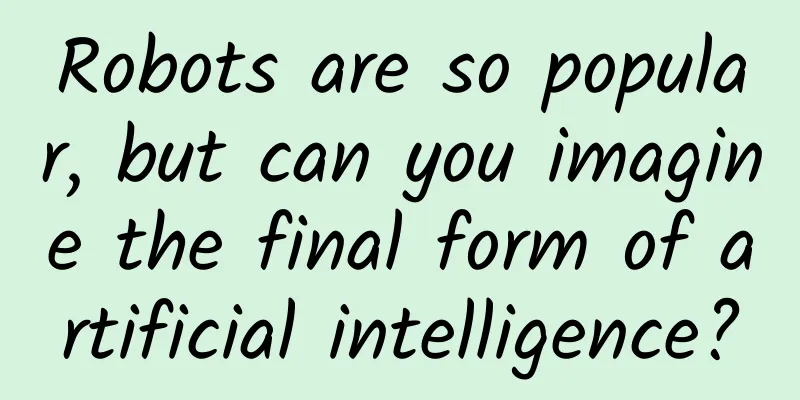Robots are so popular, but can you imagine the final form of artificial intelligence?

|
"Give you 24 hours of company, answer all your questions, be able to go up to the sky and down to the earth, possess a brain and skills that surpass humans, and ultimately save the world..." The rapid development of artificial intelligence is bringing us closer and closer to virtual scenes that once only appeared in Hollywood blockbusters. "The previous scene of the Internet was PC Internet, this scene is mobile Internet, and the bonus period of mobile Internet has basically ended. So what is the next scene? The answer is artificial intelligence." Currently, the artificial intelligence industry is ushering in an unprecedented development boom. It has not only received strong support from technology giants and the government, but also received enthusiastic calls from the user market. In this unique market environment, it is time for us to boldly imagine the future of the robotics industry. Technology is still the core of development Unlike the booming mobile phone, VR, and TV industries in the past two years, the entry threshold of the field of artificial intelligence is relatively high, mainly due to the technical threshold. Artificial intelligence is not a new concept. It has been more than 60 years since its emergence. Even after the technological explosion in recent years, there is still no phenomenal product or application like the iPhone. Each branch field also faces its own technical shackles. According to the Global Artificial Intelligence Development Report 2016, an artificial intelligence company is born every 10.9 hours in the world, and there are 709 artificial intelligence companies in China. However, despite the rapid development of my country's artificial intelligence industry, it is still far behind the international level in key technologies. Industry insiders suggest that the artificial intelligence industry must avoid the low-endization of high-end industries. Precisely because of the existence of technological barriers, it is currently difficult for any technology company in the world to expand and complete artificial intelligence projects. Just like mature industries such as automobiles and smartphones, the future of artificial intelligence also requires segmented development. Therefore, in the future we may see various sub-industries besides robot hardware manufacturing, such as voice recognition, cloud computing, machine learning, gesture control, etc. Segmented development, collaborative win-win, and applying better technologies to the field of artificial intelligence will become an effective way to curb the low-endization of high-end industries. Product quality needs to be improved Under the general environment of global scientific and technological innovation, domestic policies to support artificial intelligence are constantly being introduced, and "artificial intelligence" appeared for the first time in the draft of the 13th Five-Year Plan, indicating that artificial intelligence is being elevated to the national strategic level. Research firm Gartner predicts that by 2018, 6 billion devices around the world will use artificial intelligence technology, and people will have close contact with artificial intelligence in Internet appliances, cars, etc. Artificial intelligence that gradually enters people's lives will have unprecedented industrial opportunities. However, in the process of AI development, we can also clearly see some market chaos, such as a large number of pseudo-intelligent products flooding the market. They simply add networking or search functions to ordinary electronic products and tout them in the name of big data and deep learning. The existence of these products has largely caused ordinary users to misunderstand AI, and will also have a negative impact on the future application and popularization of the industry. Their existence also shows that there are still many gaps in the field of artificial intelligence that need to be filled by technology. Although robots serve people, some companies are also urgently needed to serve robots. For example, in order to make robots truly intelligent, it has become a consensus to build their brains in the cloud. According to CloudMinds, the world's first cloud-based intelligent robot operator, cloud computing can help robots get rid of the current situation of "lack of heart and brain" as soon as possible. It will build a reusable cloud-based robot operator's infrastructure and capabilities, including overall architecture, voice interaction understanding, high-speed network, machine vision, human-machine intelligence fusion and other core technologies. The end state of artificial intelligence Some people may ask, "What is the ultimate form of robots?" Is it the Terminator, Baymax, Avatar, or Iron Man? Perhaps these classic film and television characters are not the final form of robots. We might as well boldly predict that the ultimate form of intelligent robots is cloud-based intelligent robots. Using a cloud-based intelligent robot architecture, the "brain" performs data analysis in the cloud, and the "body" performs specific operations on site, connected through a mobile high-speed network ("nerve"), forming an intelligent robot that serves humans. That is to say, a "machine brain that is one million times the size of a human brain" is placed in the cloud, and then connected to an avatar's body through a secure, high-performance network. The robots of the future must be smart and skillful. The "smart" part is that the robots need to develop logical thinking, improve their judgment, learning and decision-making abilities, and the "skillful" part is that they need to develop flexible movements. A "smart" robot is not only an intelligent terminal, a network controller, but also a cloud computing platform capable of making decisions and providing services. In recent years, well-known high-tech companies such as Apple, Google, Microsoft, and Baidu have invested heavily in the field of artificial intelligence. If the Internet has changed the way people live, then artificial intelligence will effectively drive the improvement of the productivity of the entire society and lead the development of a new round of technological waves. It is no exaggeration to say that if the artificial intelligence industry can develop smoothly as expected, it will set off a new industrial revolution, and this revolution must be coordinated by multiple parties. As a winner of Toutiao's Qingyun Plan and Baijiahao's Bai+ Plan, the 2019 Baidu Digital Author of the Year, the Baijiahao's Most Popular Author in the Technology Field, the 2019 Sogou Technology and Culture Author, and the 2021 Baijiahao Quarterly Influential Creator, he has won many awards, including the 2013 Sohu Best Industry Media Person, the 2015 China New Media Entrepreneurship Competition Beijing Third Place, the 2015 Guangmang Experience Award, the 2015 China New Media Entrepreneurship Competition Finals Third Place, and the 2018 Baidu Dynamic Annual Powerful Celebrity. |
<<: Unmanned driving systems are really hard to understand. This article tells you the answer
Recommend
Answers to bidding promotion problems!
This week I have compiled a few more difficult pr...
Internet TV is being rectified again. Are license holders responsible for rescuing the market?
After the General Administration's strict con...
Is operation and promotion difficult? You can't handle these three user attributes
The categories of operations include data operati...
Can trigger auroras! What exactly is the origin of geomagnetic storms?
Audit expert: Zhan Mingjin PhD, Chinese Academy o...
There are so many selling points for a product, how can we find the key points that impress users?
I believe many people have encountered this situa...
What does it mean to dominate the screen with ten thousand words? How to understand the phrase "Ten Thousand Words Dominating the Screen"?
After the New Year’s Day in 2020, someone called ...
Pinduoduo, whose number of users exceeds that of Taobao, saw its share price halved. Will it become a discarded child after Tencent and Alibaba reached a peace agreement?
"Anti-monopoly" is stirring up a vortex...
[Good article] Two or three points in the planning and operation process of the points mall!
Not long ago, I was promoting a points mall + mem...
Why does this duck look so plump?
The Winter Paralympics has begun. Speaking of the...
How to create a hit marketing plan?
In 2019, we saw all kinds of people spreading kno...
Foreign media revealed the cause of Samsung Note7 explosion: manufacturing error, different battery sizes
According to the Wall Street Journal, the cause o...
【Q&A】Why did your community become a dead group? The Secret of Wu Xiaobo Channel Community Operation
Introduction: Have you ever encountered these emb...
No idea for event operation? Maybe you should read this article...
As an employee of the company, it is more accurat...
Getting started with the domestically produced Ubuntu Kylin operating system
On December 22, Ubuntu Kylin 15.04, a domestic op...
How to create your own entry in Baidu Encyclopedia? Is there any method?
Baidu Encyclopedia started in 2006. When it was f...









